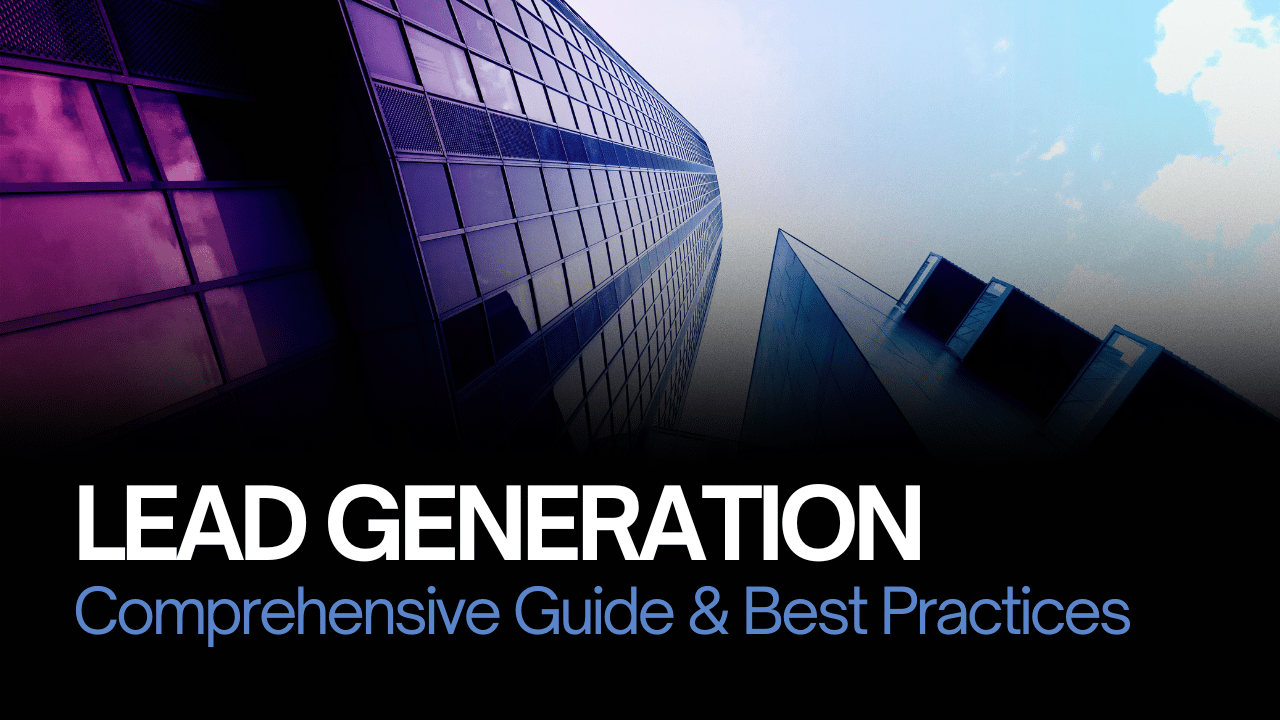Getting new customers is harder now than before. Everyone gets too many emails, social media is full of posts, and people ignore most ads. So how do you get people to notice what you're selling?
The answer is lead generation - but not the annoying kind that makes people run away. I mean building real friendships with people who actually need what you have.
What is lead generation?
Lead generation is the process of attracting and capturing the interest of potential customers in a product or service, with the goal of converting that interest into sales. It involves various marketing strategies, such as offering valuable content, free trials, or special discounts to encourage prospects to share their contact information, like an email address or phone number. For example, a software company might offer a free 14-day trial of its product on its website; visitors interested in the trial fill out a form with their contact details to access it. The company then uses this information to nurture these leads through follow-up emails, aiming to convert them into paying customers.
What are the most effective lead generation strategies?
Now that you know what lead generation is, let's talk about what really works. The key is making stuff that people actually want to see and share.
Make sure your content addresses pain points
Everything starts with knowing what problems your customers have. What keeps them awake at night? What problems are they trying to fix? What questions do they keep asking?
Let's say you sell project management software. Instead of just talking about how good your features are, make content that helps people manage projects better. Make videos about planning tips, write articles about avoiding common mistakes, or share stories showing how other companies solved similar problems.
People don't care about your product features - they care about whether you can help them. Show them you understand their problems, and they'll start paying attention.
Set up a lead scoring system
Not all leads are the same. Some people are just looking around, while others are ready to buy tomorrow. A lead scoring system helps you figure out who's who.
Here's how it works: you give points for different things people do. Someone who downloads your pricing guide gets more points than someone who just visits your homepage. Someone who joins your webinar gets more points than someone who just reads a blog post.
The people with higher points are more likely to buy, so your sales team can focus on them first. It's like having a system that helps you spend your time on the right people.
Go where your audience is
You wouldn't try to sell surfboards at a ski place, right? The same idea works for lead generation. You need to be where your potential customers already spend time.
If your customers like visual stuff (like designers or artists), Instagram and Pinterest make sense. If you're selling to business people, LinkedIn is probably better. Don't try to be everywhere - just be where your people are.
Dial in a great call-to-action
Even the best content won't get leads if you don't tell people what to do next. Your call-to-action (CTA) is like a friendly invitation - it should be clear, interesting, and easy to follow.
Instead of "Click here," try something like "Get your free planning template" or "See how this works." Make it obvious what people will get and why they should care.
Perform A/B testing for best results
Here's where things get interesting. A/B testing means making two versions of something (like an email subject line or a landing page) and seeing which one works better.
Maybe you test two different headlines on your blog post, or two different colors for your signup button. The data will tell you which version gets more people to take action. It's like having a crystal ball that shows you what your audience likes.
How do lead qualification and nurturing work?
Getting leads is just the beginning. The real magic happens when you figure out which leads are worth pursuing and how to turn them into customers.
First, you need to know what your ideal customer looks like. This is called an ideal customer profile (ICP). Think about your best customers – what do they have in common? What industry are they in? How big is their company? What problems do they need to solve?
There's a framework called BANT that helps you qualify leads:
Budget – Can they afford what you're selling?
Authority – Can they actually make the buying decision?
Need – Do they have a problem you can solve?
Timing – Are they looking to buy soon?
Lead scoring gives each lead a number based on their actions. Lead grading looks at how well they fit your ideal customer profile. Use both together and you get a clear picture of who's worth your time.
What are some methods for nurturing leads?
Once you know who your good leads are, you need to stay in touch without being annoying. Here are some ways to do that:
Email drip campaigns
These are automatic email sequences that go out over time. Maybe you send a welcome email when someone first signs up, then a helpful tip a few days later, then a case study the following week.
The key is giving value in every email. Don't just sell your product - teach them something useful or share an interesting story.
Webinars and virtual events
These are great because they let you talk directly with potential customers. You can answer their questions, show your expertise, and get a feel for how interested they really are.
A software company might host a webinar showing advanced features, with time for Q&A at the end. It's educational and selling at the same time.
Personalised content
This means changing what you send based on what you know about each lead. If someone downloaded a guide about email marketing, you might send them more content about that topic.
An online clothing store might send product suggestions based on what someone looked at on their website. It shows you're paying attention and makes the experience more relevant.
Social media
Don't just post and leave. Actually talk with people. Join conversations in your industry, share useful content, and respond when people comment on your posts.
This builds awareness and trust over time. People start recognizing your name and thinking of you as an expert.
Interactive content
Quizzes, assessments, and calculators are great for keeping people interested while learning more about them. A fitness app might create a quiz that helps people figure out their perfect workout plan, while collecting information about their goals and preferences.
What are the current trends in lead generation?
Lead generation keeps changing, and there are some exciting new things happening right now.
AI tools
Artificial intelligence is getting really good at predicting what people want to see. AI can look at someone's past behavior and suggest what content they're most likely to engage with next.
You can use AI to look at a customer's purchase history and suggest related products. It helps you understand individual customers better and spot patterns across your entire customer base.
Automation and personalisation
Marketing automation tools let you deliver personalized content to lots of people without doing it all by hand. You can set up dynamic email campaigns that change based on how people behave.
When someone feels like you "get" them, they're more likely to become a customer and stick around long-term.
Video marketing
People love videos. They're more interesting than text and easier to understand than long articles. You can use videos for product demos, customer testimonials, or educational content.
Keep them short and focused. People's attention spans are getting shorter, so make every second count. And make sure they're easy to share - word of mouth is still one of the best forms of marketing.
How do you measure the success of your lead gen strategy?
You can't improve what you don't measure, so tracking the right numbers is important for understanding your lead generation performance. The key numbers you should focus on include your conversion rate, which shows what percentage of leads actually take the action you want, and your cost per lead (CPL), which tells you how much you're spending to get each lead - for example, if you spend $1,000 on a campaign and get 200 leads, your CPL is $5. You also need to check lead quality by figuring out whether the leads you're getting are actually likely to become customers, which connects directly to your lead scoring system. Finally, your return on investment (ROI) is the ultimate measure of success, showing whether you're making more money than you're spending on lead generation efforts.
What are the best practices for lead generation?
Here are some guidelines that will help you get better leads while building trust with your audience:
Know your audience inside and out: The better you understand your ideal customers, the easier it is to create content and campaigns that speak directly to their needs.
Keep your lead qualification criteria clear: Define what makes a good lead and update your criteria regularly based on feedback and results.
Be consistent and build trust: Use clear messaging, deliver on your promises, share customer testimonials, and highlight any awards or certifications.
Use a reliable CRM system: Track every step of the lead’s journey—from the first interaction to becoming a customer.
Keep forms short and simple: Only ask for essential information. The shorter the form, the more likely people are to fill it out.
Test and optimize: Experiment with different headlines, images, and calls-to-action to find what works best for your audience.
Use AI and automation wisely: Tools like chatbots can handle basic queries, but real human support should always be available when needed.
Keep improving continuously: Talk to your sales team, study your data, and stay flexible. Make changes when something isn’t working.
Conclusion
Lead generation isn't just about collecting email addresses or phone numbers - it's about building meaningful relationships with people who genuinely need what you offer. The best lead generation strategies focus on providing real value, understanding your audience deeply, and being patient with the process. When you consistently help people solve their problems and stay genuine in your approach, you'll naturally attract high-quality leads who are more likely to become loyal customers. Remember, successful lead generation takes time to master, but the investment in building these systems and relationships will pay off with sustainable business growth for years to come.



